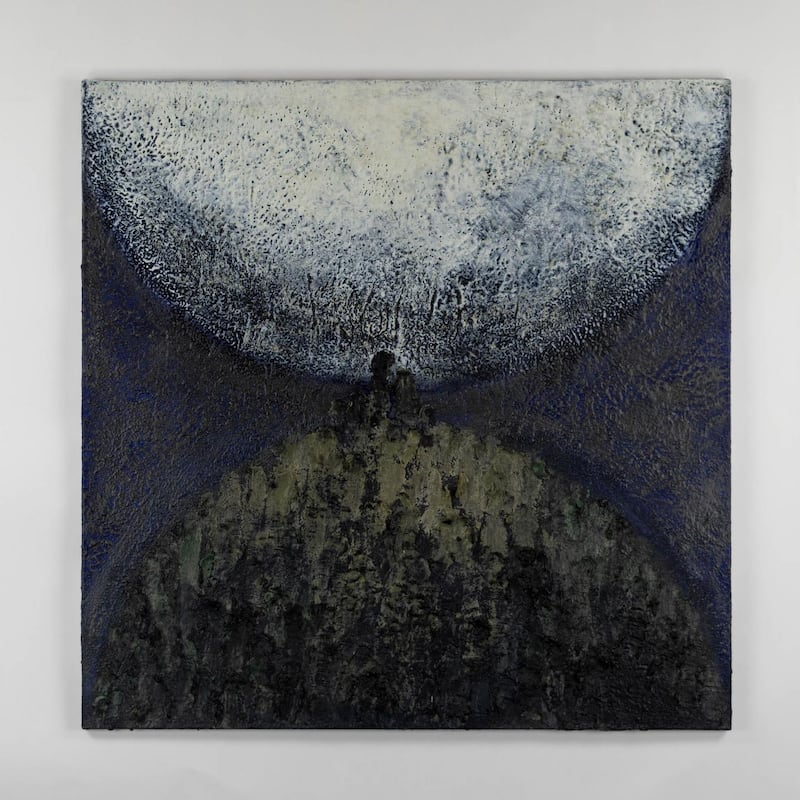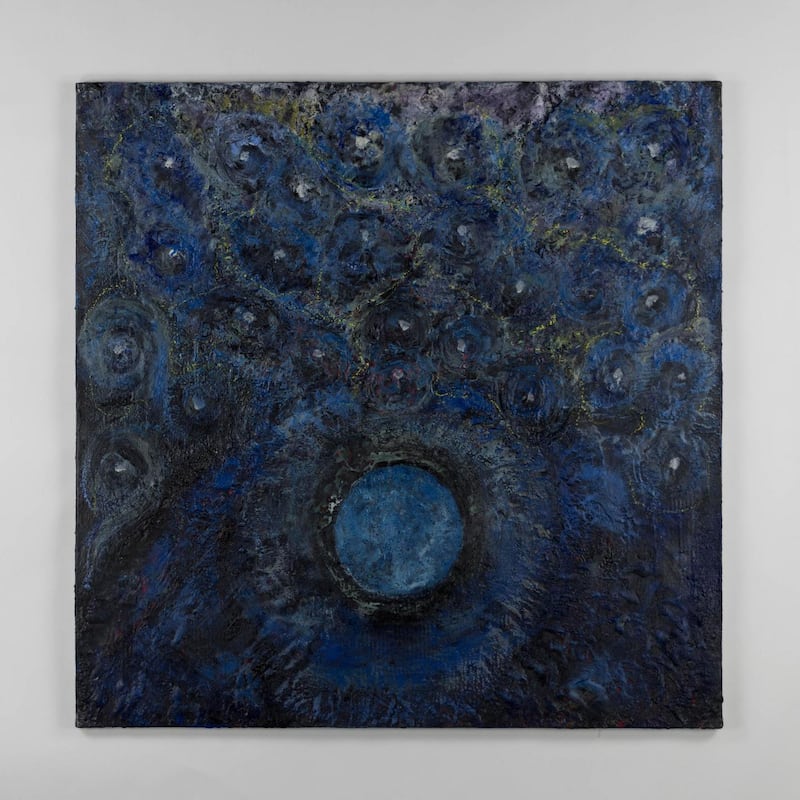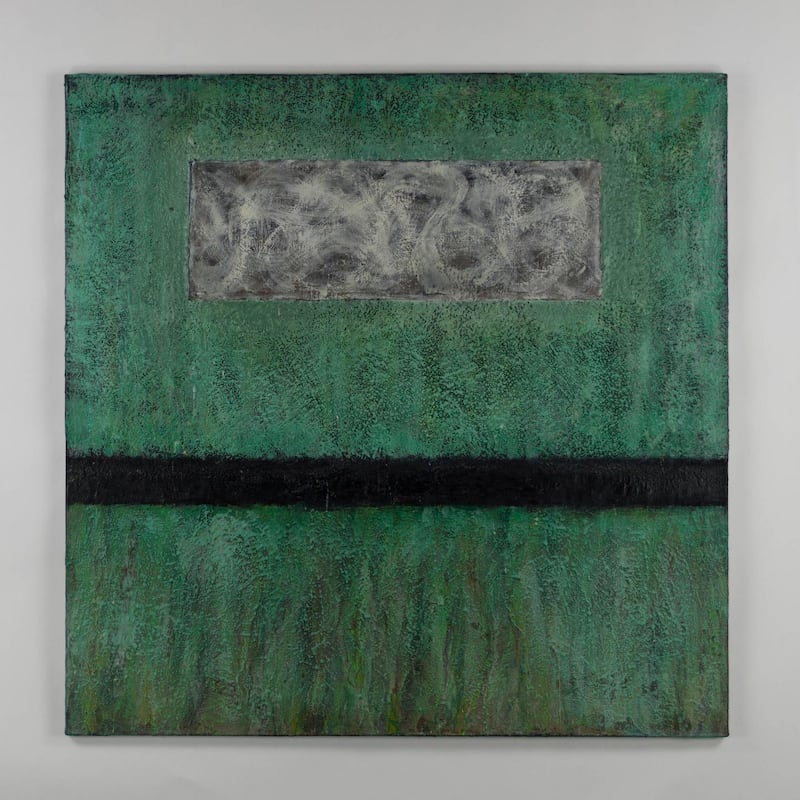As part of last year’s Kilkenny Arts Festival, Helen Comerford’s exhibition, Covid-19 April Diary, comprised a series of painted panels. The intricate grid pattern of each square panel was painted on the basis of the previous day’s Covid figures, as the grim statistics emerged – and grew alarmingly.
The red squares represented deaths. Given which, one could be forgiven for presuming that her new exhibition, The Nineteen, which forms part of this year’s festival, again alludes to the dreaded virus.
As it happens, it doesn’t. The connection is, as she notes, coincidental. And it is quite a coincidence. She was already deeply immersed in the work that makes up The Nineteen when Covid arrived on the scene last year. By April 2020 she felt she couldn’t ignore the reality of the epidemic and she put The Nineteen aside to devise and work on the Diary pieces, only resuming when that project was concluded.
The Nineteen of the title – 19 1 sq m panels – derives from her long-term interest in Rudolf Steiner’s anthroposophical ideas, ranging across science, spirituality and pedagogy, specifically his “spiritual course” of 19 Class Lessons from 1924 (as well as the 19 core lessons he delivered others, making a total of 38, the additional lessons largely elaborating on and developing aspects of the 19).
The lessons took the form of “meditative verses” with accompanying commentary. They were produced with the aim of mapping out a path of lifelong spiritual development for the individual.

That’s the scaffolding but, Comerford is quick to emphasise, not the substance. It was never about illustrating or translating the texts. In fact to do so would run counter to their spirit. Rather, they are starting points, lessons to be absorbed so that one can move on.
The work, as she says, is “experiential”, it emerges through the process of its making, through a dialogue between material and technique. “It’s always been important to me to push the limits of a material, to find the truth in the material.”
The making was prolonged and intensive. “I regard all 19 individual pieces as making up one work in a way,” she explains. “They all have to work together for me.”
The choice of material is vital and the paintings are made with encaustic, a beautiful but demanding medium that imposes its own discipline. As she describes it, there was a meditative, ritualistic quality to each day’s activity. She grinds her own pigments, and another vital constituent, damar resin.
To produce a workable paint, powdered pigment is added to heated wax and damar. So it was never a question of arriving in the studio and setting to with a brush and palette. Preparation generally absorbed about two hours, Comerford says.
The typical career template, according to which an artist arrives at a personal, clearly identifiable style and medium, and sticks with them, cannot be applied to her oeuvre
That sounds quite leisurely, in a way, but then there was a sharp change of pace: the encaustic sets as it cools and is pliable for a relatively short time. Given that she reckons that up to 60 layers have been applied to some of the panels, an immense investment of time was involved.
A handful of motifs emerge: circles and spheres feature a great deal; line, whether a solitary track extending through space or, often, multiple strands in a state of flux. Those layers of encaustic generate dense, deep, richly textured depths and expanses, tonally dark for the most part but with some dazzling exceptions, including the fiery concentric rings of Seventeen and the radiant, blossoming Nineteen. In keeping with the core inspiration, intimations of forward momentum, rhythmic cycles and moments of illumination emerge.
It is important to Comerford that, in the former refectory of St Kieran’s (where her father attended school, she notes), she has a venue in which all 19 panels can be seen together and their interrelationships can emerge and resonate. “You can refer across from One to Nineteen.” Which is fortuitous. “Covid has actually worked for me as far as that goes,” she explains.
“The show was originally intended for the old Butler Gallery last year (the new Butler has since opened; the old gallery was a sequence of several distinct rooms), but Covid scuppered that plan.” It also allowed her extra time, which was useful.
Throughout nearly five decades, although her work has at every stage displayed a firm grounding in technical ability, Comerford has, with equal consistency, resisted being identified with any one medium or set of artistic conventions.
The typical career template, according to which an artist arrives at a personal, clearly identifiable style and medium, and sticks with them, cannot be applied to her oeuvre. In its public manifestations, that oeuvre extends back to the early 1970s, though it might well have begun almost a decade earlier, when she attended NCAD, followed by Belfast College of Art and Utrecht, where she studied ceramic sculpture. Not untypically, at that stage she diverted a significant portion of her energies from artistic practice to marriage and motherhood.

She also studied Principles of Teaching, as it was then known, at NCAD, and has devoted considerable energy to the practice of teaching over the years. She was involved in setting up an art school in Kilkenny, a precursor of Callan’s lively KCAT. Various teaching and workshop residencies have continued to occupy part of her time, though definitely less so looking into the future, she intimates. “One of the good things about getting older – and there are good things about it, it’s worth mentioning – is that it allows you to say ‘no’. And I find there’s so much work I want to get on with.”
Looking back, she is not remotely negative about marriage and motherhood, it’s important to emphasise, and those experiences were not remote from her artistic concerns at the time as, gradually but also as quickly as possible, her artwork re-assumed a central role in her life.
Over a number of years, and using a wide variety of media and materials, including paper, graphite, beeswax, gauze and fibreglass resin, with great verve and confidence she created several series of sculptural works. Although abstracted, their curvaceous organic forms alluded persuasively to the feminine, including to pregnancy; as did the often-repetitive processes involved in their making, such as sewing and pattern cutting.
As with a number of artists at the time and indeed subsequently, notably including Eva Hesse, who she has long acknowledged as an important influence, Comerford’s work absorbed aspects of minimalist abstraction, including modular sequences, humanising and feminising them.
Her use of repeated elements also drew in the concept of common, communal female experience, something that became more explicit when she took to figuration in, for example, her 1983 papier-mache sculptural installation Circle of Women.

Her Covid-19 April Diary also takes the grammar of abstraction, in the form of the grid, to deal with the crisis unfolding around her and the communal experience of lockdown. Her series of paper and graphite works, exceptional pieces, prompted her to devise and make boxes to protect and transport them, and these boxes became part of the sculptures, leading on to her remarkable set of Planetary Boxes.
These geode-like carved wooden shells opened to reveal dazzling, patterned interiors incorporating additional materials and forms, several coloured vibrantly with encaustic. They are symbolic representations of celestial bodies developed according to Steiner’s ideas, and they also maintain links with the earthly, human body.
Originally from Thomastown, Comerford is settled not that far away, close to Kells, stunningly situated on the Kings River. Her home is a former farmhouse and her studio, across the farmyard, was the hay-barn. Her daily working routine has continued relatively well through the Covid pandemic: having fortunately avoided the virus, she has enjoyed a robust support system of family support.
So far, she feels, it has been for her a period of enhanced concentration. She suspects that, beyond the difficulties and indeed the tragedies, for many people it has engendered moments of reappraisal and reflection otherwise impossible in the midst of the daily grind.
Not that she is anti-social. She greatly values her association with Na Cailleacha, for example. In fact, with Patricia Hurl and Therry Rudin, she is a founder member of this collective of “eight women artists over 70.” It has proved to be a valuable forum for the exchange of ideas, information, friendship and support.
Helen Comerford's The Nineteen is on view at the Academy Hall @ St Kieran's College, College Road, Kilkenny, August 7th-15th. Admission is free. See kilkennyarts.ie


















